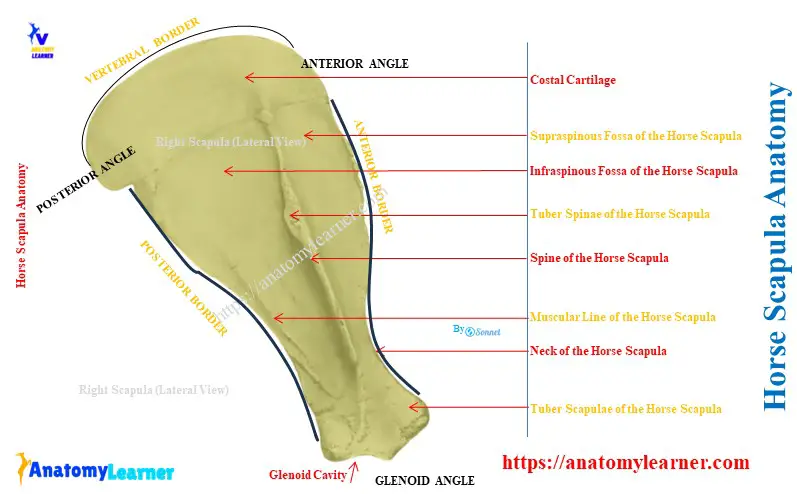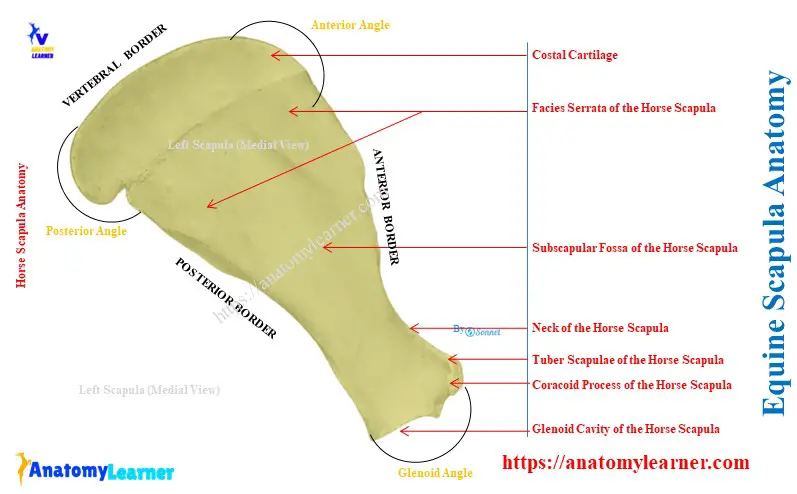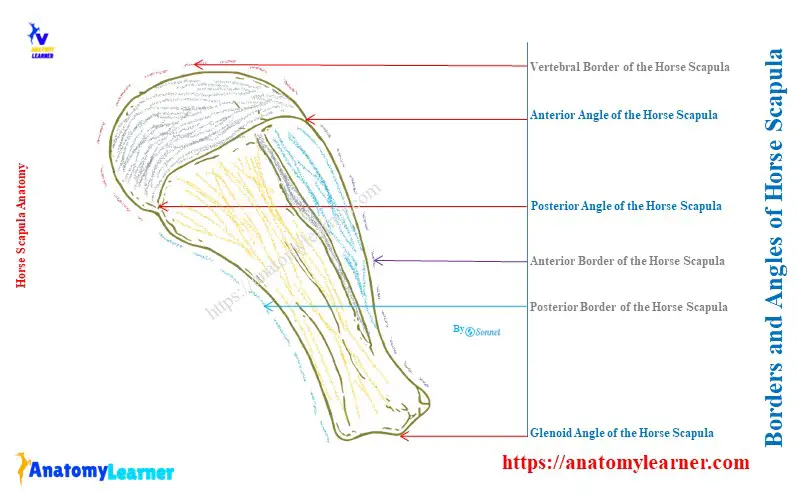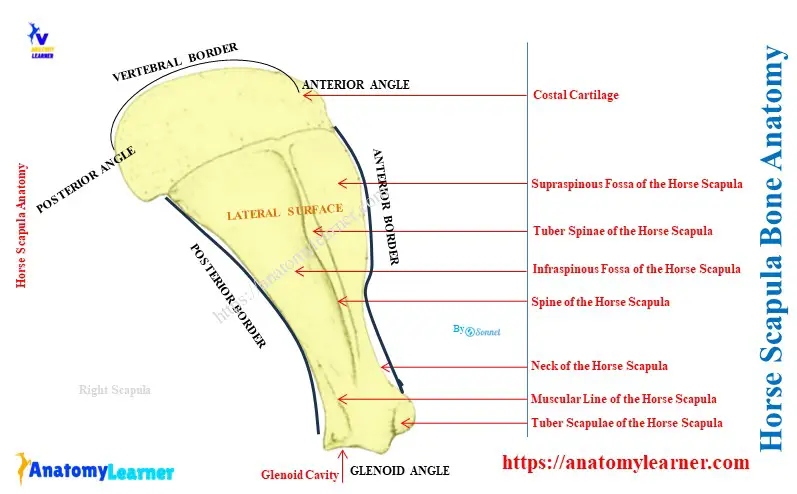The horse scapula is the first bone of its thoracic limb. Here, I will describe the osteological features of the horse scapula bone with the diagram.
Quick overview: The horse scapula is a flat triangular bone in the thoracic limb that possesses 2 surfaces, 3 borders, and 3 angles. Here, the acromion process is absent, but the tuber scapulae, coracoid process, glenoid cavity, and subscapular fossa are well-developed.
I will show you the features from every surface, border, and angle of the equine scapula. Thus, you will differentiate this scapular bone from other species, like cows, dogs, and pigs.
What is a scapula on a horse?
The scapula is a flat and triangular bone on the forelimb of the horse. This triangular flat bone of the horse forms the shoulder girdle.
It is less triangular than the scapula of the ox. This bone also possesses some unique features that make it different from the other species of scapula bones.
Where is the scapula in a horse?
The scapula is situated on the anterior part of the lateral thoracic wall of the horse. The long axis of the scapula extends obliquely from the fourth thoracic spine to the ventral end of the first rib.
The scapula of the horse curves slightly and slopes outward in adaptation to form the thoracic wall.

Unique osteological features of the horse scapula
First, let’s identify the below-mentioned osteological features from the horse scapula bone –
- Lateral and medial surfaces of the scapula,
- Spine and tuber spine on the lateral surface,
- Supraspinous and infraspinous fossae from the lateral surface,
- Deep subscapular fossa from the medial surface,
- Borders of the scapula: dorsal or vertebral, anterior, and posterior,
- Amgles of the scapula: anterior, posterior, and glenoid,
- Neck of the scapula at the distal part, and
- Glenoid cavity, notch, tuber scapulae, and coracoid process at the distal extremity,
Now, let’s enlist the unique osteological features of the horse scapula –
- The spine is placed further backward in the horse scapula than the cow,
- There is no acromion process in the equine scapula,
- infraspinous, supraspinous, and subscapular fossae are deep,
- The glenoid cavity and notch are also deeper than the other species,
- The coracoid process is well-developed in the horse, and
- The tuber scapulae or supraglenoid tubercle is large and located further away from the glenoid cavity,
Horse scapula bone anatomy
For description purposes, the horse scapula bone has two surfaces, three borders, and three angles. The surfaces, borders, and angles are –
- Surfaces: lateral and costal (medial),
- Borders: anterior, posterior, vertebral (dorsal), and
- Angles: anterior (cervical angle), posterior (dorsal angle), and glenoid (articular angle).
Here, the diagram shows the surfaces, borders, and angles from the equine scapula bone. But you will find the details labeled diagrams on the different parts of the scapula in the next section.

The lateral surface of the equine scapula
The lateral surface of the equine scapula presents a spine. This spine divides the lateral surface into two unequal halves –
- Supraspinous fossa: it is located in front of the scapula spine and
- Infraspinous fossa: it locates just behind the scapula spine.
The supraspinous fossa is comparatively small and covered with the supraspinatus muscle. Again, the infraspinous fossa is larger and wider at the proximal part. It becomes narrow and contains several muscular lines.
The whole infraspinous fossa of the scapula is covered with the infraspinatus muscle. At the neck of the scapula, you will find several nutrient foramina and the vascular groove.
Here, the spine of the equine scapula does not extend like the spine of the ox scapula. It extends from the vertebral border to the neck of the scapula.
The free edge of the scapular spine is thick, blunt, and rough. Thus, the spine does not contain the pointed acromion process in the horse.
The costal surface of the horse scapula
The costal or medial surface of the scapula is hollowed in its length by the subscapular fossa. This hollow area occupies nearly the whole of the lower part of the medial or costal surface.
A pointed and separated triangular area is also present at the proximal part of the costal surface. These are the facies serrata, where the serratus ventralis muscles attach.
At the distal part of the medial surface, there is a vascular groove with several branches.
Borders of the equine scapula anatomy
The proximal part of the anterior border of the equine scapula is convex. However, the distal part of the anterior border is concave and smooth.
The posterior border of the equine scapula is slightly concave. It is thick and rough at the proximal part. But the posterior border is thin in the middle and thick and the distal part.
The vertebral border of the young horse is thick and pitted with the impression. Within this border, the scapular cartilage fits.
The lower edge of the cartilage fits the depression and the elevation of the bone. Here, the free edge of the costal cartilage is thin and convex. It lies in the vertebral spine of the horse.
The lower part of the cartilage is less ossified compared to the upper part. It helps to form the bony vertebral border of the scapula.

Angles of the horse scapula
The anterior angle of the horse scapula is also known as the cervical angle. It is at the junction of the anterior and vertebral borders.
The anterior angle of the horse scapula lies opposite to the second thoracic spine. It is relatively thin and is about the right angle.
The posterior angle of the equine scapula is also known as the dorsal angle. It is thick and rough and lies opposite the vertebral end of the seventh rib.

Another name for the glenoid angle is the articular angle of the scapula. It joins with the body of the scapular bone by the neck.
The glenoid angle is large in the sagittal direction. It contains a deep glenoid cavity for the articulation with the head of the horse femur bone.
The glenoid cavity of the horse scapula is oval in outline. It possesses a glenoid notch on its margin.
The posteriolateral part of the glenoid cavity is tuberous, where the tendon of the teres minor attaches. Here, the supraglenoid tubercle (tuber scapulae) is larger and located superior to the glenoid cavity on its cranial aspect.
The tendon of the biceps brachii is attached to the supraglenoid tubercle of the equine scapula. Again, a developed coracoid process projects from the medial aspect of the supraglenoid tubercle. From this process, the coraco brachialis muscle arises.
Summary of the equine scapula
Table 1 shows the summary of the equine scapula bone –
| Horse Scapula | Features |
| Lateral surface | Present spine Divides lateral surface into two unequal supraspinous and infraspinous fossa Tuber scapula at the middle of the spine |
| Costal surface | Present deep subscapular fossa Possess two facies serrata |
| Anterior border | Proximal part: convex and rough Distal part: concave and smooth |
| Posterior border | Slightly concave Upper part: thick and rough Middle part: thin Lower part: thick |
| Vertebral border | Thick and pitted with impressions It contains the costal cartilage |
| Anterior angle | Relatively thin |
| Posterior angle | Thick and rough |
| Articular angle | Contain deep glenoid cavity Larger supraglenoid tubercle Well-developed coracoid process |
Conclusion
So, the horse scapula is a flat triangular bone located on the cranial part of the lateral thoracic wall. It has two surfaces, three borders, and three angles for the description.
The tuber scapula is further backward, and the spine does not contain the acromion process. All the fossae, cavity, and notch are deep in the horse’s scapula compared to the other’s scapula.

